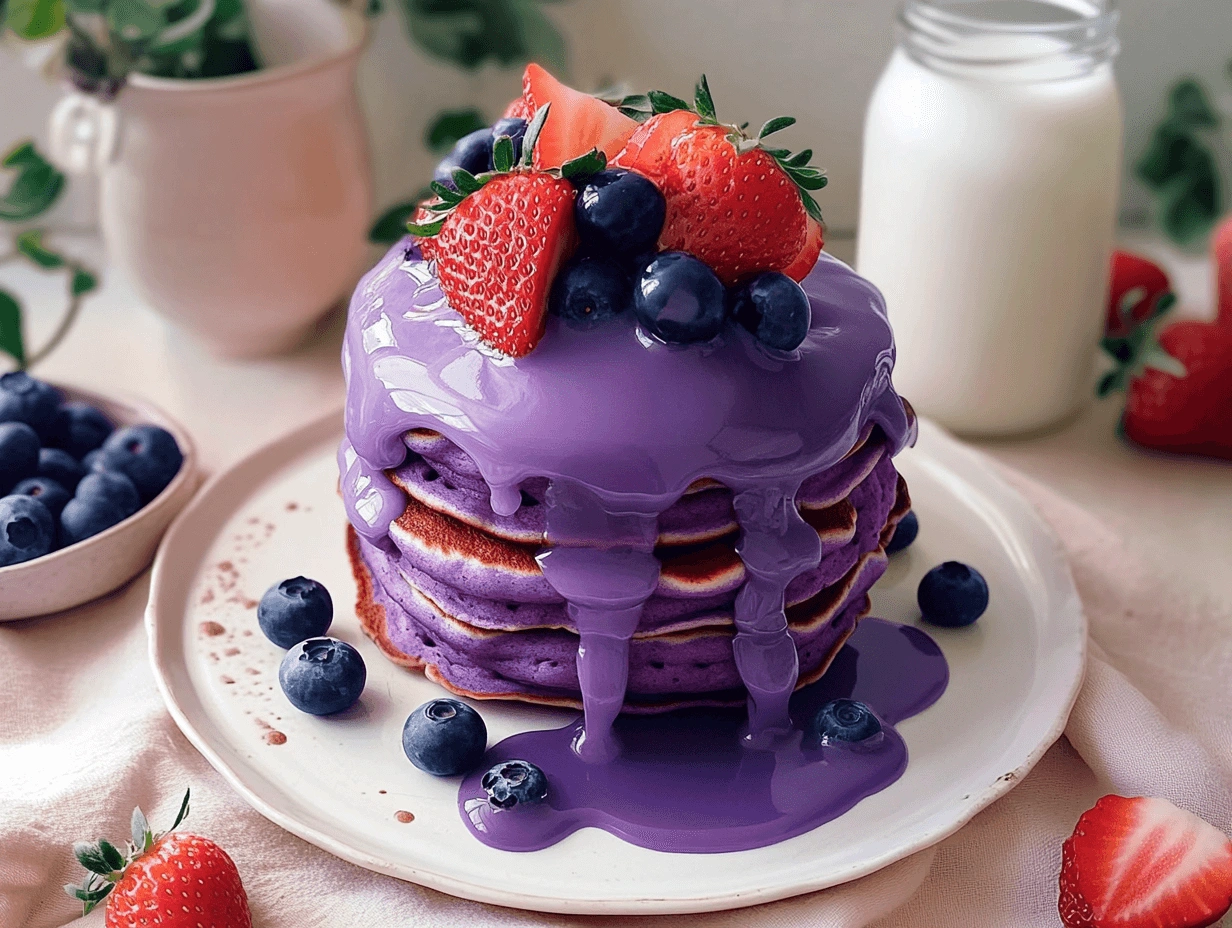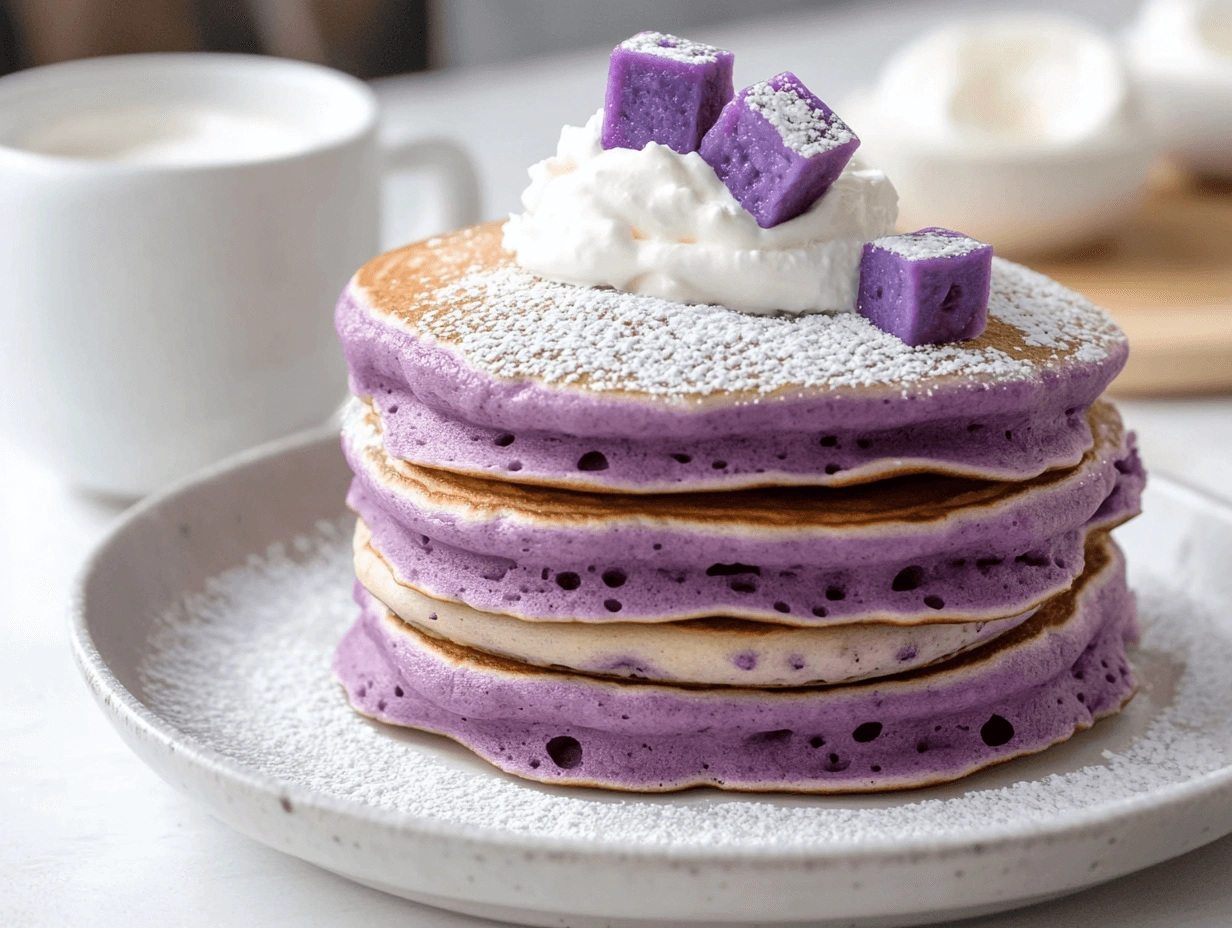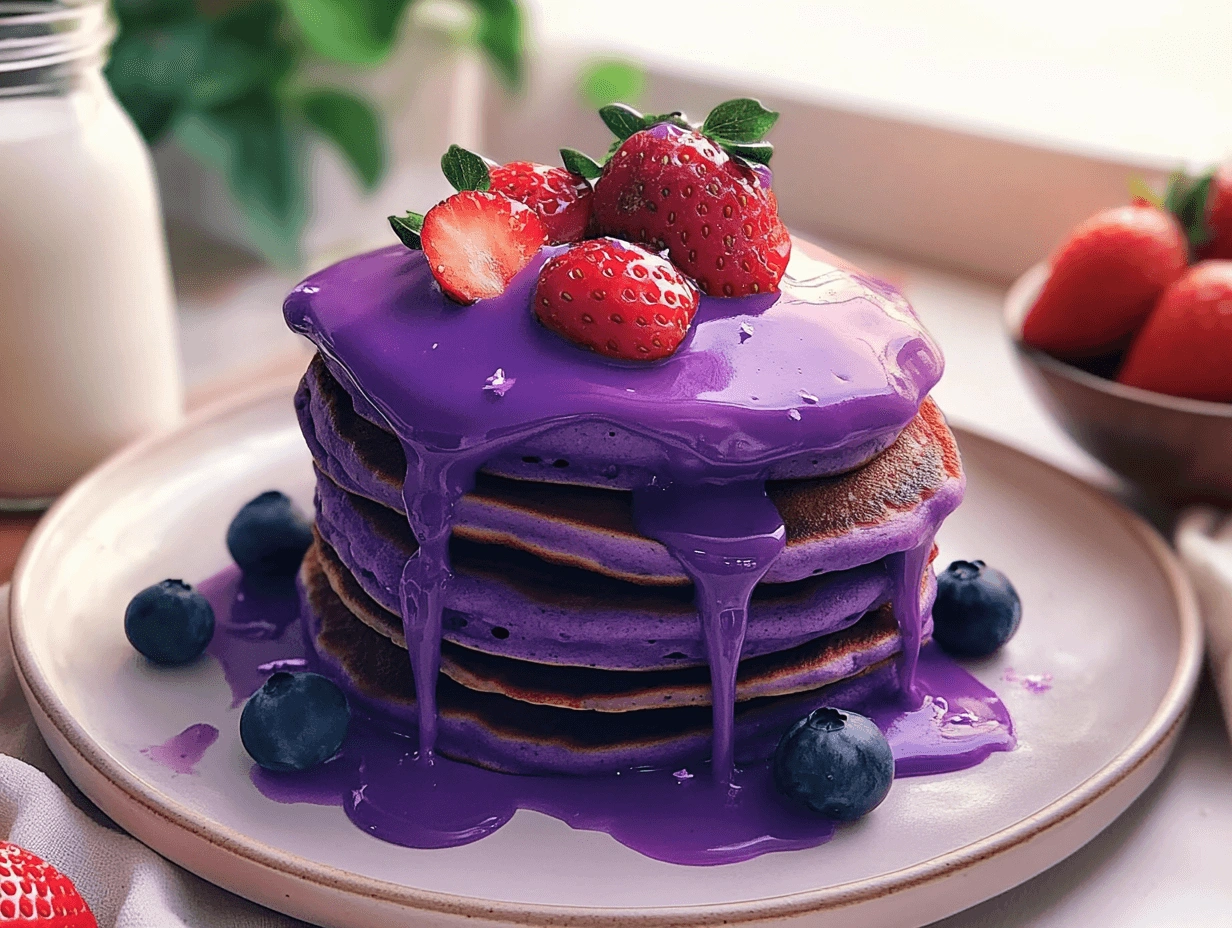Introduction to Taro Pancakes
Why Taro is Special
Taro, a root vegetable cherished by many cultures, has been a staple ingredient in dishes worldwide for centuries. In Hawaii, for instance, it is considered a symbol of life and is central to traditional recipes like poi. Similarly, in Southeast Asia, taro is widely used in both sweet and savory dishes. Thanks to their versatility, taro pancakes have become a popular breakfast option, admired for their distinct taste and colorful presentation.
Why People Love Taro Pancakes
Taro pancakes have recently become widely popular for a variety of reasons. First, their striking purple color makes them visually appealing, especially for food enthusiasts who love sharing photos online. Additionally, their soft and fluffy texture makes them a delightful option for breakfast or brunch. Moreover, taro is packed with nutrients, making these pancakes a wholesome and flavorful treat.
A Quick Look at the Recipe
Preparing taro pancakes is easier than it seems. To start, basic ingredients like flour, eggs, and milk are combined with taro powder to create a smooth batter. When cooked, the pancakes turn out fluffy, flavorful, and perfect for pairing with various toppings. For example, coconut syrup, fresh fruit, or chopped nuts can elevate their flavor and add a pleasing texture.
Understanding Taro as an Ingredient

What is Taro, and Where Does it Come From?
Taro is a tropical root vegetable that thrives in warm and humid climates. For instance, it originated in Southeast Asia but eventually spread to Polynesia, Africa, and the Caribbean. Over time, taro has become a staple in many cuisines worldwide due to its mild, nutty flavor and creamy texture.
Why Taro is Good for You
Taro is not only delicious but also packed with essential nutrients. For example, it provides fiber, which helps with digestion and promotes gut health. Furthermore, its low glycemic index makes it a smart choice for people managing blood sugar levels. Additionally, taro is rich in vitamins B6 and C, along with minerals such as potassium and magnesium, which contribute to overall health.
Types of Taro Used in Cooking
There are two common types of taro:
- Eddoe Taro: This smaller variety has a mild, nutty flavor and is often used in soups and stews.
- Dasheen Taro: Known for its larger size, this type has a starchier texture and works well in desserts.
When making pancakes, most people prefer taro powder or paste. These forms are not only convenient but also ensure consistent flavor and color, which is especially important for batter-based recipes.
Key Ingredients for Taro Pancakes
Basic Ingredients and Their Jobs
To prepare taro pancakes, you will need a few simple ingredients. Each one serves a specific purpose:
- Flour: Provides the structure for the batter.
- Taro Powder: Adds the signature taro flavor and vibrant purple color.
- Eggs: Bind the ingredients together and contribute to the pancakes’ fluffy texture.
- Milk: Makes the batter smooth and easy to pour.
- Sugar: Balances the taro’s earthy taste with a hint of sweetness.
Extra Ingredients for More Flavor
If you want to elevate the flavor of your pancakes, consider including these optional ingredients:
- Vanilla Extract: Adds a sweet, aromatic touch to the batter.
- Natural Food Coloring: Enhances the purple hue for a more visually appealing dish.
- Coconut Syrup: Complements the tropical flavor of taro perfectly.
Toppings to Try
Adding toppings can make your pancakes even more special. For instance:
- Shredded Coconut: Adds a crunchy texture and a tropical feel.
- Fresh Fruit: Bananas, strawberries, or mango slices provide a refreshing contrast.
- Macadamia Nuts: Offer a nutty crunch that pairs beautifully with the pancakes’ soft texture.
Tools You Need to Make Taro Pancakes
Helpful Kitchen Tools
Using the right tools can make preparing taro pancakes much easier. For example:
- Mixing Bowls: Use separate bowls for wet and dry ingredients to prevent lumps in the batter.
- Whisk: Ensures the batter is smooth and airy, resulting in fluffy pancakes.
- Sifter: Removes clumps from dry ingredients, making them easier to mix with the wet ingredients.
Cookware for Perfect Pancakes
The correct cookware ensures your pancakes cook evenly and don’t stick. For this reason, a non-stick skillet or griddle is highly recommended. Additionally, a heat-resistant spatula makes flipping pancakes easy, ensuring they stay intact and look great on the plate.
Preparing the Batter
Preparing the batter is a crucial step in achieving light and fluffy taro pancakes. By following these steps closely, you can ensure perfect results.
Step-by-Step Guide
- Separate Egg Whites and Yolks:
- To start, crack your eggs and carefully separate the whites from the yolks. This step is essential because whipping the egg whites later will incorporate air, resulting in fluffier pancakes.
- Mix Dry Ingredients:
- Next, sift the flour, taro powder, sugar, and baking powder into a large mixing bowl. Sifting not only removes lumps but also ensures that the ingredients are evenly distributed.
- Combine Wet Ingredients:
- Meanwhile, in another bowl, whisk together the egg yolks, milk, vanilla extract, and melted butter. Then, gradually pour this wet mixture into the dry ingredients. Stir gently until combined, but be careful not to overmix, as this can make the pancakes dense.
- Whip the Egg Whites:
- Using a whisk or an electric mixer, beat the egg whites until stiff peaks form. Afterward, fold the whipped egg whites into the batter gently to maintain the airiness.
Tips for Achieving the Perfect Batter Consistency
- Ideally, the batter should have a thick yet pourable consistency, similar to heavy cream.
- If the batter seems too thick, add milk one tablespoon at a time until the desired consistency is reached. On the other hand, if it’s too runny, mix in a small amount of flour to thicken it.
Cooking Taro Pancakes

Once your batter is ready, the cooking process demands careful attention to heat and timing. By doing so, you can ensure perfectly cooked pancakes every time.
Heat Control and Skillet Preparation
- Preheat Your Skillet:
- First, heat a non-stick skillet or griddle over medium heat. To test if it’s ready, sprinkle a few drops of water onto the skillet. If the water sizzles and evaporates quickly, the skillet is at the correct temperature.
- Grease Sparingly:
- Next, lightly grease the skillet with butter or neutral oil. Be sure to spread it evenly to prevent sticking while avoiding an overly greasy surface.
How to Flip Pancakes Without Breaking Them
- Pour and Spread the Batter:
- Pour about 1/4 cup of batter onto the skillet. Then, use the back of a spoon to gently shape it into a circle.
- Wait for Bubbles:
- Once bubbles begin to form on the surface and the edges appear set, carefully slide a spatula under the pancake and flip it quickly but gently.
Signs of Perfectly Cooked Pancakes
- Ideally, the surface should be golden brown and evenly cooked.
- When you press the pancake lightly, it should spring back, indicating that it is fully cooked on the inside.
Perfect Pairings for Taro Pancakes
Pairing taro pancakes with the right sides and beverages can make your breakfast experience even more delightful.
Coconut Syrup: How to Make or Source It
- Homemade Coconut Syrup:
- For a homemade option, combine coconut milk, sugar, and a splash of vanilla in a saucepan. Simmer the mixture until thickened, then drizzle it generously over your pancakes. Check out this homemade rice cake recipe guide for additional inspiration on how to pair syrup with unique creations.
- Store-Bought Options:
- Alternatively, you can purchase coconut syrup at most grocery stores. Look for brands that use natural ingredients for the best flavor.
Beverage Pairings: Teas and Coffees That Complement the Dish
- Teas: Matcha or jasmine tea pairs wonderfully with the earthy taro flavor, offering a delicate aroma.
- Coffees: On the other hand, a lightly roasted coffee adds a subtle bitterness that balances the creamy sweetness of the pancakes.
Sides That Enhance the Experience
- Tropical Fruit Platter: Consider serving mango, pineapple, or papaya for a refreshing contrast.
Creamy Additions: Additionally, a dollop of plain yogurt or whipped cream can add a tangy or creamy element to the dish.
Troubleshooting Common Issues: Taro Pancakes
Even with meticulous preparation, occasional challenges may arise. Fortunately, most problems are easy to address with minor adjustments.
Pancakes Too Dense or Too Runny
- Dense Pancakes:
- To fix dense pancakes, ensure the egg whites are whipped to stiff peaks and folded in gently. Moreover, avoid overmixing, as it can deflate the air bubbles and result in heaviness.
- Runny Batter:
- If the batter is too thin, gradually add more flour until it reaches the right consistency.
Avoiding Burnt Pancakes
- Always cook pancakes over medium or medium-low heat. High heat might burn the outside while leaving the inside undercooked.
- Additionally, wipe the skillet clean between batches to remove any burnt residue that could affect the flavor.
Solutions for Uneven Cooking
- To achieve consistent results, use a griddle, which distributes heat more evenly.
- Moreover, pour smaller amounts of batter to ensure the pancakes cook through uniformly.
Creative Variations of Taro Pancakes
Taro pancakes are versatile and lend themselves to endless creativity. Here are some exciting variations to try:
Adding Chocolate Chips or Matcha for Fusion Flavors
- Chocolate Chips: Stir chocolate chips into the batter for a sweet, melty addition that complements the earthy taro flavor.
- Matcha Powder: Alternatively, add a teaspoon of matcha powder to the dry ingredients for a vibrant green tea twist.
Vegan and Gluten-Free Adaptations
- Vegan Pancakes: Replace eggs with a flaxseed or chia seed mixture (1 tablespoon seeds + 3 tablespoons water). Similarly, use almond or soy milk instead of dairy milk.
- Gluten-Free Pancakes: Substitute all-purpose flour with a gluten-free blend. To ensure proper structure, opt for a blend that contains xanthan gum.
Using Fresh Taro Instead of Taro Powder
- If you prefer, peel and boil fresh taro until soft. Then, mash it into a smooth paste and incorporate it into the wet ingredients. However, you may need to adjust the milk quantity to achieve the right batter consistency.
With these creative ideas, you can make each batch of taro pancakes unique and exciting!
Serving and Presentation Tips: Taro Pancakes
Serving taro pancakes is not only about flavor; it is also about creating an inviting presentation. By following a few simple tips, you can make your pancakes look as delicious as they taste.
How to Plate Pancakes Beautifully
- Layering for Height: To start, stack three to five pancakes neatly on a plate. This not only creates visual appeal but also makes the dish feel more substantial.
- Artistic Syrup Drizzling: After stacking, use a small spoon or a squeeze bottle to drizzle coconut syrup, honey, or maple syrup in a spiral or zigzag pattern for a professional touch.
- Adding Pops of Color: Additionally, pair the pancakes with brightly colored fruits like strawberries, blueberries, or kiwi for a stunning contrast.
- Symmetry Matters: For a well-balanced presentation, arrange fruits, whipped cream, or other toppings evenly around the stack.
Using Garnishes to Add Flair
- Edible Flowers: For an elegant touch, sprinkle edible flowers such as pansies or marigolds on top.
- Shaved Chocolate or Coconut: Alternatively, sprinkle shaved chocolate or toasted coconut for added texture and a luxurious look.
- Powdered Sugar Dusting: Lastly, lightly dust powdered sugar using a sieve. This adds a polished and appetizing finish.
Storing and Reheating Leftover Pancakes
- Storage Tips:
- Allow pancakes to cool completely before storing them to avoid sogginess.
- Place parchment paper between each pancake when stacking them in an airtight container. This prevents sticking.
- Store in the refrigerator for up to three days or freeze for up to three months.
- Reheating Techniques:
- Microwave: Cover a pancake with a damp paper towel and microwave for 20–30 seconds. This prevents them from drying out.
- Oven: Preheat the oven to 350°F (175°C), arrange pancakes on a baking sheet, and warm them for 5–10 minutes.
- Skillet: For a crispy edge, reheat pancakes over low heat in a non-stick skillet for a few minutes on each side.
Frequently Asked Questions About Taro Pancakes
Taro pancakes might be new to many people, so it is natural to have questions. Below are detailed answers to the most common queries.
Can Taro Pancakes Be Made Ahead of Time?
Yes, taro pancakes can be prepared ahead of time, making them perfect for busy mornings. You can either:
- Cook and Store: Prepare the pancakes as usual, let them cool completely, and store them in an airtight container. When you are ready to eat, simply reheat them using one of the methods mentioned earlier.
- Prepare the Batter: Alternatively, prepare the batter ahead of time and refrigerate it overnight. However, it’s best to whip and fold in the egg whites just before cooking to maintain their fluffy texture.
Substitutes for Taro Powder
If you do not have taro powder on hand, there are several excellent substitutes:
- Fresh Taro Paste: Boil and mash fresh taro until smooth, then mix it into the wet ingredients. Be sure to adjust the liquid quantities to maintain the desired batter consistency.
- Purple Sweet Potato Powder: This option mimics taro’s starchy texture and subtly sweet flavor while adding a vibrant purple hue.
- Ube Powder: Although slightly different in flavor, ube powder can be a great alternative that still provides a unique and colorful result.
Shelf Life and Storage Tips for Taro Pancakes
- Cooked Pancakes:
- To keep them fresh longer, freeze them for up to three months.
- Taro Powder:
- When stored in a cool, dry place, taro powder typically lasts 1–2 years. Check the packaging for the best-before date.
Conclusion and Final Tips: Taro Pancakes
Taro pancakes are a wonderful fusion of flavor, texture, and creativity. By mastering the preparation and experimenting with serving ideas, you can turn a simple dish into a memorable meal.
Recap of Key Points for Successful Taro Pancakes
- Batter Preparation: Whipping and folding in the egg whites is crucial for light, airy pancakes.
- Cooking Technique: Use medium heat, wait for bubbles to appear before flipping, and maintain an evenly greased skillet to achieve a golden finish.
- Presentation Matters: From layering pancakes to adding colorful fruits and garnishes, presentation elevates the dining experience.
Encouragement to Experiment and Share Your Creation
Do not hesitate to put your own twist on this versatile recipe. For example, you can add matcha powder for a green tea flavor or fold in chocolate chips for added sweetness. Share your creations with friends and family to spread the joy of cooking with taro.
A Call to Embrace Taro’s Versatility in Other Dishes
Taro is not just for pancakes—it can be a star ingredient in numerous other dishes, from savory stews to sweet desserts. If you’re inspired to explore more taro-based recipes, check out Allrecipes’ taro recipes for practical cooking ideas.
By following these tips and techniques, you can confidently make taro pancakes that impress both the eyes and the palate. Whether you are making them for breakfast, brunch, or a special treat, this recipe is sure to become a household favorite. So grab your ingredients and start flipping—you will not be disappointed!


1 thought on “How to Make Perfect Taro Pancakes”